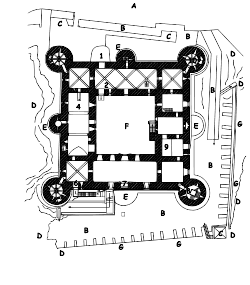Castello Ursino
| Ursino Castle | |
|---|---|
| Castello Ursino | |
| Catania, Sicily, Italy | |

View of the castle
|
|

Plan of the castle's first floor
|
|
| Coordinates | 37°29′56″N 15°5′5″E / 37.49889°N 15.08472°E |
| Type | Castle |
| Site information | |
| Open to the public |
Yes |
| Condition | Intact |
| Site history | |
| Built | 1239–1250 |
| In use | 13th–19th centuries |
| Events | Sicilian Vespers |
Castello Ursino ('Bear Castle'), also known as Castello Svevo di Catania, is a castle in Catania, Sicily, southern Italy. It was built in the 13th century as a royal castle of the Kingdom of Sicily, and is mostly known for its role in the Sicilian Vespers, when it became the seat of the Sicilian Parliament. The castle is in good condition today, and it is open to the public as a museum.
Castello Ursino was built between 1239 and 1250, as one of the royal castles of Emperor Frederick II, King of Sicily, closing a chapter on the turbulent time in Sicily that followed the death of his predessor, William II. Local lords had attempted to assert independence, and in 1220 Frederick II had ordered the destruction of all non-royal castles in Sicily. Castello Ursino was built to stress royal power as well as for the defence of the capital, and was considered impregnable at the time.
In 1295, during the Sicilian Vespers, the Parliament which declared deposed James II of Aragon as King of Sicily, replacing him with Frederick III, was held here. The following year it was captured by Robert of Anjou but was later again in Aragonese hands.
King Frederick III resided in the castle, as well as his successors Peter II, Louis, Frederick IV and Maria. Here the latter was kidnapped by Guglielmo Raimondo III Moncada to avoid her marriage with Gian Galeazzo Visconti (1392). King Martin I held also his court in the castle.
...
Wikipedia
